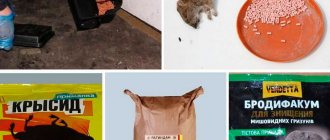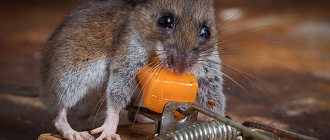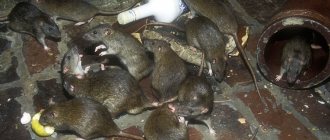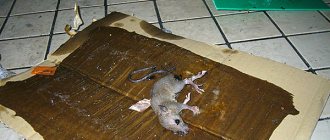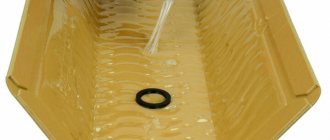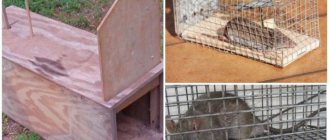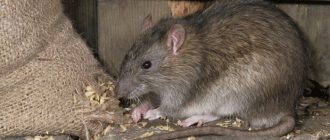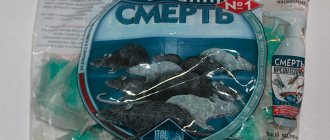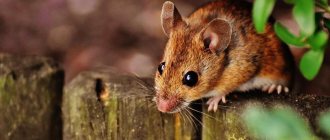Author: Michael Potter Updated: April 17, 2020
There are two types of rat baits: food (non-toxic) - for luring rats into a trap, and poisonous - for killing rodents. Food baits can be used for all types of rat traps, and poisons are most often used in conjunction with special stations for safety reasons. In this review we will talk about the 8 best poisons for rats and mice.
After ingesting poison, rodents die within a few hours to several weeks. Mice are smaller than rats and can die within a day, but rats die more slowly (a week or two). Poison baits are toxic and can kill any animal, including pets (cats and dogs), squirrels, raccoons and other wild animals. Be careful when using them around your pets and small children. Otherwise, instead of using poisons, you are better off purchasing an ultrasonic pest repeller to safely eliminate the animals that are bothering you.
Poison Ingredients: How Do Rodenticides Really Work?
Rodenticides are toxic to rodents, but, unfortunately, to humans too. All these baits bring death. Therefore, rat poisons are best used in conjunction with stations (like the Protecta LP Rat Bait Station for ~$18.49).
The active ingredients in rodenticides, which are classified as anticoagulants (such as warfarin, diphasinone, and bromadiolone), interfere with blood clotting, causing severe internal bleeding and ultimately death.
Products containing active substances other than anticoagulants are toxic in various ways. They can affect the nervous system (for example, bromethalin). They increase calcium levels in the blood, leading to kidney, liver or heart failure (eg cholecalciferol).
All poisons also belong to two different generations.
First generation poisons kill rodents slowly because they have a cumulative effect. For rodents to die, they need to eat the poison for several days, rather than just taste it once. Most rat and mouse baits these days fall into this group.
Second generation poisons (for example, containing bromadiolone, brodifacoum) can kill pests after just a single dose of the poison.
Poisons come in both block, granule and bar form (individually wrapped to help maintain the freshness and smell of the bait), etc.
- Using poison bait is usually less expensive than trapping because it is less labor intensive and rats do not have to be checked every day. Thus, in large rooms it is more profitable to use poisons.
- You should be aware that mice and rats can learn to identify baits and avoid them. To prevent this, scientists advise first laying out food bait to lull the vigilance of rodents, and then replacing it with a poisoned one.
- Liquid rat poison works great in dry areas.
Poisons and animals (cats, dogs)
Please note: There are no rat poisons that are safe for your pets! All poisonous baits are created to kill animals and can also harm cats and dogs. Be very careful: if the poison is swallowed, severe poisoning can occur. If you are concerned about pets, try an alternative method: electronic repellers. To get rid of rats, use only powerful repellers with a large area coverage.
User Cesar Rueda of the site warns: “Please be very careful when using bait if you have a dog. She won't be able to get into the bait station, but many rodents have a tendency to pull out and hide bits of poison all over the backyard..."
To prevent your cats or dogs from accidentally eating poison in the yard, you can, for example, attach poison to a strong wire on the fence or hide pieces of the toxic product in places where your pets do not go - and then wait for the dead rats.
“Just use the poison in garages and attics – ie. in areas where your children and pets would not normally go. It is possible that dying rats or mice will go outside and be eaten by other animals (though if you live in an urban area the likelihood is low compared to rural areas), but usually most die near the area where you used the product. After the death of a rodent, an unpleasant odor will certainly appear, which is why the poison must be used with caution in places where it will then be difficult to find the corpse and remove it.”
Yes, poisons kill rodents. But you don't know where exactly they will die. Dying rodents are looking for a quiet place, and you will be lucky if they manage to get outside. But it is possible that their death will happen right in your house or barn, then an unpleasant surprise awaits you - the smell of dead rats.
The mechanism of action of the poison
It is impossible to say for sure how rat poison acts on mice.
It all depends on the main active ingredient of the drug and the additives included in its composition.:
- Warfarin-based drugs act on the circulatory system of the rodent. They lead to blood thinning and the spread of hemorrhages.
- Preparations containing zinc phosphide affect the respiratory system.
- Baits containing arsenic depress the rodent's nervous system.
- Phosphorus-based products destroy bone tissue.
In addition, there are drugs containing dicumarol, diphenacin, phentolamine, kemochlor, which, when accumulated inside the body, lead to failure in all internal organs and the slow death of mice.
Barium fluoroacetate and glyftor cause the blood to rapidly clot, killing the animal almost instantly.
How long will it take for a rodent to die?
How long it takes for mice to die from poison depends on two main factors: the composition of the drug and the amount of bait consumed.
A poison with a delayed effect will only take effect when a sufficient amount of poison has accumulated in the body.
If a toxic substance is supplied in small quantities over a long period of time, there is a high probability of resistance developing in rodents. That is why baits need to be replenished.
Instant poisons kill mice within a few hours. A poison with a delayed effect begins to act on days 2–3 if a lot of bait has been eaten.
If not, it is necessary for the poison to accumulate and cause disruption in the functioning of all systems of the rodent’s body. This may take from 3 to 10 days. This is why many owners begin to think that the poison has no effect on the mouse.
Comparative table of poisons from rats and mice
| Product | Type of poison | Active Ingredient | Speed of action on rodents | Price |
| Tomcat All Weather Bait Chunx, 4 Lb | Small blocks | Diphasinone | Kills slowly, requires several meals | ~$24.46 |
| JT Eaton 709-PN Bait Block Rodenticide Bait | Small blocks | Diphasinone | Kills slowly, requires several meals | from ~$24.49 |
| D-Con Ready Mix Baitbits Mice Rats | Granules | Brodifacoum | A single dose is enough | ~$31.99 |
| Farnam Home & Garden Just One Bite Bar | Single block (with the ability to divide into smaller ones) | Bromadiolone | A single dose is enough | ~$9.02 |
| Havoc Rat & Mouse Bait | Granules | Brodifacoum | A single dose is enough | ~$73.59 |
| Protecta LP Rat Bait Station | Bait station | – | – | ~$14.30 |
| Rat death | Bait | Brodifactum, Rocentide | A single dose is enough | 53 RUR |
| Bait granules “Help” | Bait | Diphasinone | Kills slowly, requires several meals | 29 RUR |
| Bait granules “Ratron” | Bait | Brodifactum | A single dose is enough | 226 rub. |
| Tomcat Mouse and Rat Poison Bait | Liquid poison | Diphasinone sodium salt | Kills slowly, requires several meals | ~$19.62 |
The most frequently asked questions about Havoc Rat & Mice bait
Can I use Havoc inside my home? What's the best way to do this?
Yes, Havoc Rat & Mice Bait can be used indoors. You can either scatter the granules around or simply open the bag and place it where the rats are active.
There are mice in my attic. Can I put bait there? It's quite difficult for me to get into the attic, so I'm afraid that the smell of dead mice will bother my family later.
Unfortunately, the smell will be there in any case, because... not a single bait dehydrates the rodent from the inside (only in this case the smell could be less strong). In a situation like yours, the two most acceptable options are to make the attic entrance more accessible and place poison there, or to use an electronic rat repeller.
What is the shelf life of the product?
You don't have to worry about this: Havoc bait can be stored for up to 4 or 5 years, and such a long storage period will not affect its effectiveness since the bags are securely sealed.
Is it true that Havoc is equally effective on rats and mice?
Yes, in practice, bait attracts and kills both mice and rats equally well.
Attention! You should know that rats and mice are very cunning creatures, so if they see that someone has died from bait, they may refuse such a treat. Therefore, if you see that animals do not eat it, buy another product.
How to prepare poison for mice at home that is safe for other animals
You can make poison for uninvited guests yourself, using improvised means . These baits will be completely safe for humans and pets.
Their action is not as fast as that of chemical drugs, so you can completely get rid of mice in several procedures.
Recipes for preparing poison.
- Mix buckwheat with alabaster in a ratio of 1:3. Place a container of water next to the bait. After a meal, the rodent will want to drink, which will lead to swelling of the alabaster inside.
- Combine sugar with quicklime in a 1:2 ratio. Rodents will not ignore the sweet powder, and when lime reacts with moisture, gases will begin to be released, the temperature will rise and the stomach will swell. This will lead to inevitable death.
- Mix gypsum with corn flour in equal quantities. Add a little warm milk to the mixture to form a stiff dough. Roll the resulting mass into balls and place them in rodent habitats. The plaster in the stomach will harden and clog the rodent's intestines.
Be sure to read:
How to deal with mice in an apartment, what to do: effective methods and means
What is the best bait to use for traps?
There are many options to choose from – you just have to know the best way to replace your rodent trap. We remind you that for this you need not poisoned bait, but food or natural bait! You must choose the best way to lure unwanted neighbors inside the trap. This is a necessary step because if the bait does not attract rats, they will never fall into the trap - and your rat problem will never be solved.
Have you heard of the “great rat eradication”? This is an example of a large campaign aimed at getting rid of rats en masse. We hope that those reading this article have only encountered a small population of rats in their home - and using natural baits in traps will help solve the problem of catching and killing rats.
You can choose any of the following options:
- Peanut Butter: This is actually more effective than the cheese we often see in rodent cartoons. Rats are very attracted to peanut butter.
- Chocolate: The sweet smell of chocolate makes mice and rats come out of their hiding places to enjoy this treat.
- Bread: Plain bread or bread with a little butter on it is very effective as bait.
- Ropes, cotton wool: excellent materials for bait. Rodents use them to strengthen and insulate their nests.
Physical means
Electric Trap Rat Killer
Conventionally, they are divided into exterminators and repellents. The former are needed to destroy rodents, the latter - to scare away. Conventionally, exterminators are divided into traps and traps. In the first case, the destruction of the rodent occurs at the moment it touches the bait, in the second - after capture. Sometimes traps are intended only to catch a rodent, and the owner will decide for himself what to do with it next.
Traps
Classic mouse trap
Plastic mousetrap
Traps A standard mousetrap can be made in different ways. The basis of the mechanism is a spring kept in a cocked state. When the rodent takes the bait, the spring straightens and the impact mechanism is activated.
The impact mechanism is not necessarily made of metal. It only takes a little force to kill a mouse, which is why plastic traps have become popular lately. After removing the rodent's corpse, the trap can be cocked again and repeated many times.
This is a simple, convenient and very effective tool. The intelligence of mice does not allow them to understand the danger of such structures, so the use of such mousetraps is very effective.
The disadvantage of such designs is that you will have to deal with numerous corpses of mice , some of which (if the staple successfully hits the rodent's head) will have a very unattractive appearance.
Traps
Sticky traps
Electronic mousetrap Victor
Universal Rat Zapper Trap by Victor
Traps come in a variety of types, from homemade structures made from plastic bottles to small electronic chambers or holes that electrocute rodents. This group also includes sticky traps coated with especially adhesive compounds, both containing poison and not containing it.
Recently, devices from Victor, which are boxes with a high-voltage source powered by ordinary batteries, have gained great popularity. The mouse is attracted by the smell of the bait, crawls inside and receives an electric shock.
At the same time, unlike traps, there is no mechanical damage to the mouse’s body and there is no need to wipe the floor stained with entrails: the corpses of mice are removed from the trap without physical contact with them. The power of traps can be very different, and they exist in various modifications: not only for mice, but also for rats.
Release forms
There are different poisons that can be used to poison mice and rats. Both concentrated preparations for preparing baits yourself and ready-made products are available. They are produced in the form of briquettes, granules, gels, processed grains and seeds, powders, flakes, liquids, pastes.
It is important to know! Any bait must be placed in places inaccessible to children and pets.
Blocks
Most often, it is foreign manufacturers who produce baits in the form of solid nodules - blocks. They can be large or small, with or without holes for threading onto rods.
Granules
The crushed grain mixture with the addition of a chemical is formed by an extruder into solid granules, similar to compound feed or dry dog food. This form is preferred by mice, although rats will also eat them.
Bruschi
Ready-to-use solid nodules in the form of bars usually have foreign preparations. Manufacturers recommend placing them in special stations.
Corn
Crushed or whole grains, cereals, and their mixtures are coated with poison and painted in bright colors. This form is more suitable for poisoning mice.
Liquid poison
Liquid solutions of active ingredients in water, oil, alcohol or ethylene glycol are more effective in fighting rats, especially if there are no easily accessible sources of water nearby. But there is not always such a hard-to-reach place where a saucer or bowl will fit.
Gel
The rodenticide in the form of a gel is produced in two types:
- ready-to-use drug;
- concentrate for making your own baits.
Effective against rats, mice and voles. The ready-to-use drug may leave marks on the surface to which it was applied. Therefore, it is recommended to place it on substrates made of thick paper, polyethylene, or plastic.
Powders
The powders consist of wheat, oat or barley flour mixed with a blood anticoagulant and a small amount of sugar. They are effective for most objects, but you need to prepare poisoned baits yourself. When mixed, they generate dust, and this is dangerous for humans, so they must be handled with extreme caution.
Soft briquettes
The texture of soft briquettes resembles dense dough. Rats like them because they look like meat. Convenient to use. They are painted in bright colors, distinguishing them from ordinary food products.
Interesting! Rats usually have a preference for animal products.
Briquettes “Quiet hour”
In this case, we are talking about baits that are made on a paraffin basis, so these products will not be afraid of moisture. They can be used in winter or during heavy rains. The granules do not lose their shape for a long time.
Each package contains 7 briquettes. At the same time, they differ in their taste depending on the preferences of the rats in terms of food. One package (65 grams) of an effective rat repellent is enough to kill 3 large rats. Accordingly, depending on the size of the population, it is necessary to purchase the required number of briquettes.
Smoke bombs
Such products are effective and inexpensive. In addition, with the help of smoke bombs you can get rid of not only annoying rodents, but also fungus, mold, various insects that poison life and even ticks. However, such products should also never be used in city apartments.
The active component of these drugs is sulfur. To use a checker, you must first study the instructions for a specific product in detail. After this, you need to remove flowers, food, and animals from the premises being treated. Once ignited, the bomb begins to emit very acrid smoke. It penetrates into all the cracks and corners of the room. Thus, pests are practically smoked out of the house. During the burning of the checker, you need to carefully monitor that a pet does not enter the house or a child runs into it. After treatment, you can forget about many pests for quite a long time. But many note the difficulty of using this method, which is why smoke bombs are at the end of the list in the rating.
Source
Powders for burrow pollination
Another original and very effective remedy is powder, which is blown under pressure from a special sprayer into a hole and settles on all its walls, on the ceiling and on the floor. A rat, running through such a pollinated area, stains its fur with powder, and then, at its leisure, licks all this fur and poisons itself.
Rat holes that can be sealed in minutes
The product works very effectively, and its reliability is higher the more powder is blown into each hole and the deeper it penetrates here. Efficiency is increased even more due to the fact that, having stained the fur in the powder, the animal then wipes the fur on the still clean walls in the deeper parts of the hole, and here other rats, including cubs, will be soiled in this powder brought by it.
Such powders are almost ideal for exterminating rats in open areas of large enterprises - they systematically fill holes, the exits of which are then blocked with foam. At home, they can only be used in the absence of pets who can find and eat a poisoned rat, all stained with poison.
Reasons for appearance
Rodents choose a home where it is warm and easy to get to food. If these conditions are met, gray animals try to get into a house or apartment. Owners of private houses often suffer from rodent infestations, but mice also appear in high-rise buildings, especially with the onset of cold weather.
Mice come into your home in the following cases:
- the house is unsanitary;
- the cold outside forces rodents to look for a habitat with more favorable conditions than a damp basement or frozen yard;
- free access to cereals, flour, cookies, grains;
- holes in the floor and baseboards, cracks in doors, cracked wooden parts that are easy for rodents to climb through.
